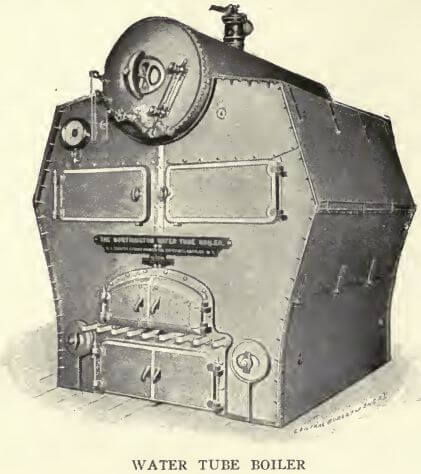Table of Contents
- Types of Gold Dredges
- Components of a Gold Dredge
- Bucket Line
- Dredge Ladder
- Lower Tumbler
- Upper Tumbler
- Screen
- Tables and Sluices
- Stacker
- Dredge Pumps
- Winch
- Hull
- Steel Super-Structure
- Dredge Engines
- Boiler
- Electrical Equipment
- Power Plants
- Dredge Sizes and Capacities
- Dredging
- Conditions
- Dredging Possibilities
- Dredging Dry Placers
We are the first and only concern in this country to devote its whole attention exclusively to the designing and building of gold dredges; therefore, we are especially well equipped to do this work much better and more quickly than other concerns; for with them, dredge building is only a side line, and their principal business, which receives their best efforts, is the manufacturing of some other lines of product. Some of our engineers were taken from the California dredging fields, and thus we have the advantage of the many lessons learned in that country.
 We have done much to develop dredge architecture and to promote gold dredging in general ; therefore, to those interested in this subject, we suggest the reading of our booklet on “Drills and Prospecting,” illustrating the Empire Hand Prospecting Drill and its application in determining the values and characteristics of dredging or placer ground. It also contains much valuable information and many tables of use in placer and dredge mining, and it will be sent on application.
We have done much to develop dredge architecture and to promote gold dredging in general ; therefore, to those interested in this subject, we suggest the reading of our booklet on “Drills and Prospecting,” illustrating the Empire Hand Prospecting Drill and its application in determining the values and characteristics of dredging or placer ground. It also contains much valuable information and many tables of use in placer and dredge mining, and it will be sent on application.
We are the first concern to make a specialty of export work, and we are particularly well equipped to handle this line, being familiar with the conditions existing in most of the gold-bearing placers of the world. We have recently equipped many of these properties with successful dredges.
Types of Gold Dredges
In the experimental period of dredge construction in this country, many failures resulted in attempting to use the hydraulic, or suction, and the dipper and clam-shell types of dredges.
These failures were due to several circumstances: First, the suction dredge did not lift any appreciable amount of gold. Second, it did not clean uneven and hard bedrock. Third, in the dipper and clam-shell types the joints in the buckets could not be made water-tight and most of the gold was lost with the great rush of water through these joints. Fourth, these types deposited the material in large quantities, at intermittent periods, whereas a continuous feed is most essential to the close saving of gold.
We build but the one type of dredge for gold mining, namely, the elevator bucket type now universally recognized as unquestionably the best machine for handling a maximum quantity of material at a minimum cost.
Components of a Gold Dredge
An Elevator Bucket Dredge comprises:
First, a Digging Apparatus at the bow of the boat, raising and delivering the material into a screen.
Second, a Revolving or Shaking Screen located about amidships for the sizing and washing of the material.
Third, an Elevator, or Stacker, at the stern, which conveys the over-size material from the screen to a necessary distance behind the dredge and on to the tailing pile.
Fourth, a Gold Saving Device for recovering the precious metal from the material passing through the perforations of the screen.
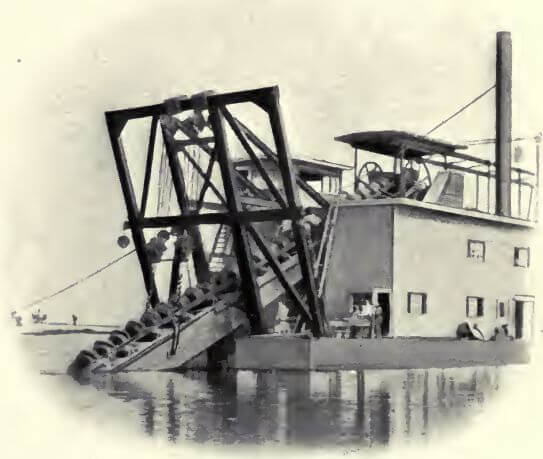
Fifth, a Pumping Apparatus furnishing an ample water supply for washing and sluicing the gravel.
Sixth, a Winch controlling the two bow lines, two stern lines and a head line, as well as the spud lines. By these means the dredge may be placed and held in any position necessary for its operation.
Each element is complete in itself and is combined in regular coordination, mounted on a scow, and forming a complete, simple and practical excavating, screening, washing and stacking apparatus, the operation of which is practically automatic and continuous.
All the above is operated by two men per shift at a cost as low as two and one-quarter cents, and seldom exceeding eight cents per cubic yard.
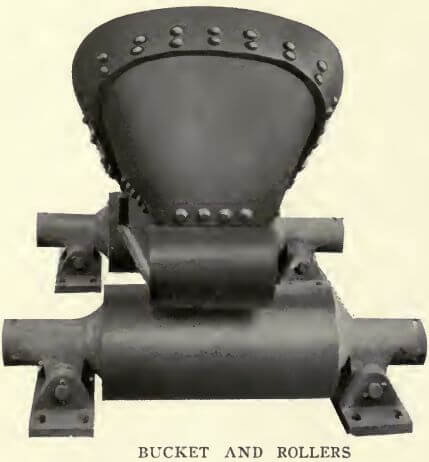 We generally advise the stacker type of dredge, which is in part a combination of gold-saving tables with a tailing stacker at the rear of the dredge for elevating the over-size material from the screen. Under some conditions, we recommend the sluice-box type of dredge of the single lift style, wherein the buckets dump the material into a short screen with large perforations, the under-size passing through the screen and falling directly into a long sluice-box which saves the gold and conveys the tailing a distance from the stern of the dredge: this does away with the stacker or elevator.
We generally advise the stacker type of dredge, which is in part a combination of gold-saving tables with a tailing stacker at the rear of the dredge for elevating the over-size material from the screen. Under some conditions, we recommend the sluice-box type of dredge of the single lift style, wherein the buckets dump the material into a short screen with large perforations, the under-size passing through the screen and falling directly into a long sluice-box which saves the gold and conveys the tailing a distance from the stern of the dredge: this does away with the stacker or elevator.
Bucket Line
The excavating apparatus consists of an endless chain of buckets of great weight and strength that will cut and dig, not only the gravel, but the bedrock. The action of the buckets is slow and powerful, so that the gold-bearing gravel is picked up in mass with very little agitation. As the buckets are water-tight, there is no opportunity for the gold to be lost
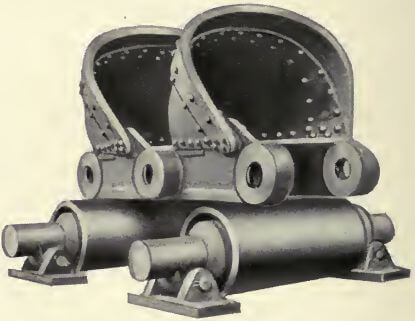
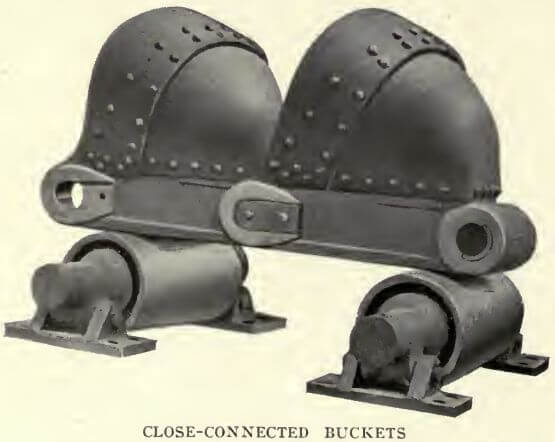
and the material is delivered into the washing and separating screen in an almost continual stream under the best conditions for the saving of the metallic content.
Generally the close-connected type of bucket line is used, that is, each bucket connected directly to the next one; but under some conditions, the open type is advisable. Then the buckets are spaced by a connecting link, thus giving alternate bucket and link.
This link is so constructed that in digging it also carries about a third of a bucketful of material. It is so made that the hood and lip, completing the bucket, may be put on to the link after the dredge has been operated some time, if the ground should prove this to be advisable, thus making a close-connected bucket line, as illustrated on page 4.
Dredge Ladder
The ladder is of the built-up girder type made of angles and plates most substantially braced and reinforced throughout its length (built in sections for transportation) and hung by its upper end to the main gantry on massive steel castings.

Lower Tumbler
At the lower end of this ladder a lower tumbler is carried in heavy cast steel, water and grit-proof bearings. This tumbler is made of a special tough, hard, cast steel and fitted with manganese steel wearing plates that are readily renewed when worn out.
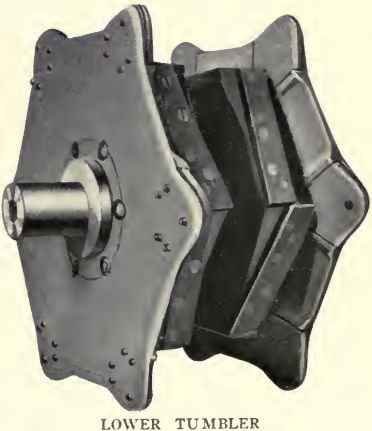
Upper Tumbler
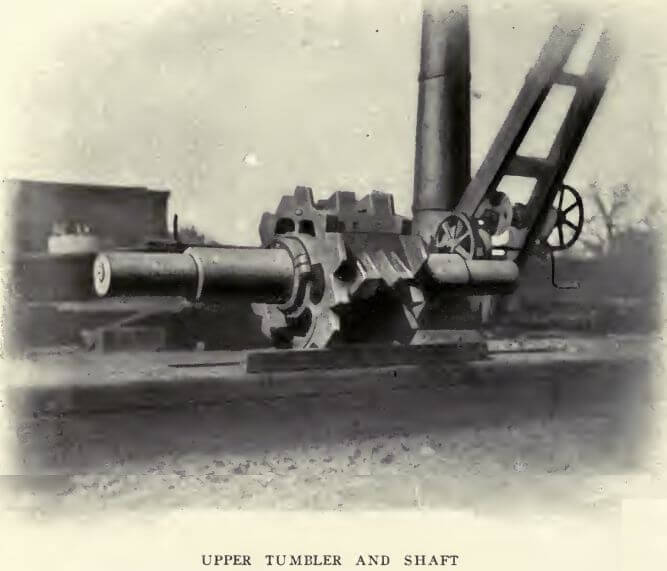
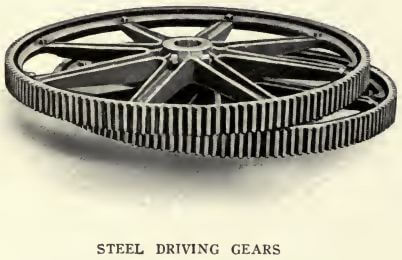 The upper tumbler, which drives the bucket line, is faced with renewable manganese steel plates and is carried on a shaft just beyond the upper end of the ladder; this shaft is driven by a double set of cast steel gears mounted on each end of the shaft with the upper tumbler between them. This driving of the upper tumbler shaft from both ends prevents its twisting and breaking in the middle, as so often happened with the old style of single drive from one end of shaft only.
The upper tumbler, which drives the bucket line, is faced with renewable manganese steel plates and is carried on a shaft just beyond the upper end of the ladder; this shaft is driven by a double set of cast steel gears mounted on each end of the shaft with the upper tumbler between them. This driving of the upper tumbler shaft from both ends prevents its twisting and breaking in the middle, as so often happened with the old style of single drive from one end of shaft only.
All of this driving gear is mounted on structural steel work so as to be self-contained and always in perfect alignment. Carrying rollers are mounted on the ladder every few feet, for 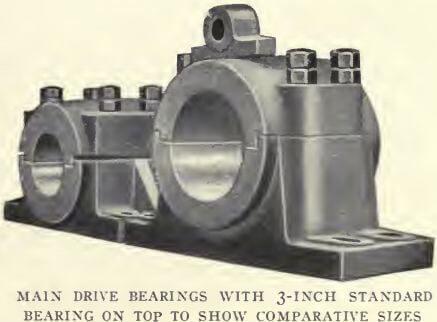 the buckets to travel over; these rollers revolve in dirt-protected bearings of the ball and socket order, so that they adjust themselves to any uneven movement of the ladder and never get stuck.
the buckets to travel over; these rollers revolve in dirt-protected bearings of the ball and socket order, so that they adjust themselves to any uneven movement of the ladder and never get stuck.
Each roller, with its shaft is cast all in one piece, thus doing away with the old trouble of their becoming loose on the shaft. The ladder, with its line of buckets, is raised from the outer end by a separate winch driven by the main bucket line engine or motor. This arrangement obtains the benefit of the largest power unit in the dredge to raise the ladder as quickly as possible, as time occupied in raising the ladder is lost in digging.
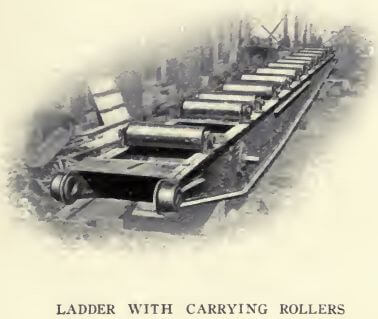 The digging end of the dredge is the most important part, as the data from operating dredges show that at least twenty-five per cent of all the stoppages and troubles on board are due to the bucket line. Therefore, we have made every effort to develop this end to its highest efficiency, and our buckets, pins, lips, etc., are larger, stronger and heavier than those of any other manufacturers. The material as it is dug and elevated is dumped into a hopper, from which it is fed into the screen.
The digging end of the dredge is the most important part, as the data from operating dredges show that at least twenty-five per cent of all the stoppages and troubles on board are due to the bucket line. Therefore, we have made every effort to develop this end to its highest efficiency, and our buckets, pins, lips, etc., are larger, stronger and heavier than those of any other manufacturers. The material as it is dug and elevated is dumped into a hopper, from which it is fed into the screen.
Screen
This screen is either of the revolving  or shaking type, depending on the character of the material to be handled, and it is set on a grade so that the material gradually travels through its length, while a perforated water pipe furnishes ample water to all parts of the screen for thoroughly washing the gravel and releasing all the gold contained therein.
or shaking type, depending on the character of the material to be handled, and it is set on a grade so that the material gradually travels through its length, while a perforated water pipe furnishes ample water to all parts of the screen for thoroughly washing the gravel and releasing all the gold contained therein.
Our revolving screens are carried on rollers which are mounted in special water and grit-proof bearings. The shafts are cast as an integral part of the roller so as to avoid many troubles that arise from these rollers coming loose on their shafts. Ample adjustment is provided in these bearings for all wear.
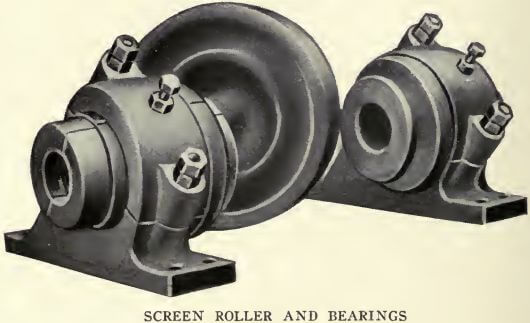
Tables and Sluices
The smaller gravel and sand pass through the perforations of the screen, together with the gold, and are distributed evenly, by a special device, over the tables, which are designed to suit the various characteristics of the gold. This distributing device is most important, and it automatically provides each table with its requisite proportion of gravel so that there is no overloading of any one table. The gold is caught either by interference, or by gravity, often by the aid of quicksilver. Gold, microscopically fine, is thus successfully recovered by our design of distributing device and tables. Most of the gold is recovered on the first few inches of the tables, but sluice-boxes are provided with angle iron riffles (which gives a good wearing bottom) to convey the tailing to the stern of the dredge. Very little gold ever travels so far, thus proving the efficiency of the tables as a gold saving device.
Stacker
The over-size material that is discharged from the end of the screen is deposited on the conveyor belt, which runs on specially constructed rollers, mounted in water-proof bearings, and carried on a structural steel ladder similar to the digging ladder, but lighter in construction. The now barren gravel is discharged on the tailing pile at such a height as to prevent interference with the movements of the dredge.

Dredge Pumps
Our centrifugal pump, for furnishing the water for all washing purposes, is specially designed for this particular work, being of large diameter and running at a moderate speed, thus giving durability and economy. It is direct-connected to a marine engine, in our steam dredge, and to an electric motor, in the electrically-driven dredge. This pump furnishes ample water to the screen for all washing purposes. A smaller pump is used for cleaning up, washing down the decks, pumping out the bilge, and priming the larger pumps.
In some instances a centrifugal sand pump is required for elevating and conveying fine tailing a distance to the rear of the dredge.

Winch
One of the most important features of operation is the method of handling the dredge, and it is owing to this excellence in our design of winch that a machine handling 5000 cubic yards per day requires only two men on a shift to operate same.
This facility in moving the dredge is accomplished by the use of a winch or winding engine, having six or more drums, under the direct control of the operator, or winchman. The four side lines run from this winch to each corner of the dredge and are then led to the shore and anchored.
A fifth, the head line, leads from another drum to the bow and forward, and is anchored a few hundred feet ahead of the dredge, thus holding it in position against the digging bank.
By the four side lines and the one head line the operator can place and hold the dredge in any position he desires by a simple movement of levers.
The throttle valves and controlling apparatus for all of the machinery of the dredge are placed in a pilot house, so situated as to command a full view of the operations. The winchman has direct control of all of the apparatus on the dredge through a number of levers arranged similarly to those in a railroad switching tower and placed in the pilot house.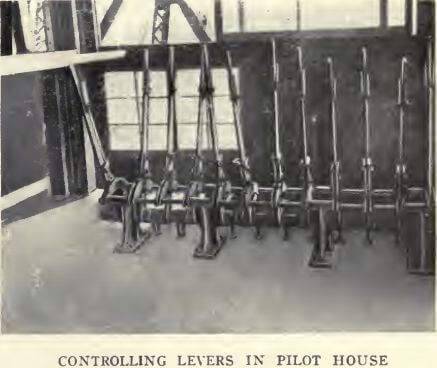
On our electrically-driven dredge, the switchboard and all various motor controls are located in the pilot house under the hand of the winchman, and the only other help required on board is an oiler, or motorman.
Our winch has many distinctive features; each drum is mounted in its own independent bearings at each end and is not carried by the shaft, as ordinarily arranged. Therefore, there is no difficulty in lubricating the bearings of the drums and the shafts are not strained by the pull of the lines on the drums or by the power or pressure exerted by applying the brakes to the drums. The sole function of the shaft is to carry the clutches that revolve the drums. These points will be readily appreciated by all experienced winchmen.
The winch is far stronger and simpler than any other, similar machine of today. It is assembled in a massive frame of structural steel so that the alignment is perfect and permanent and the whole is self-contained.
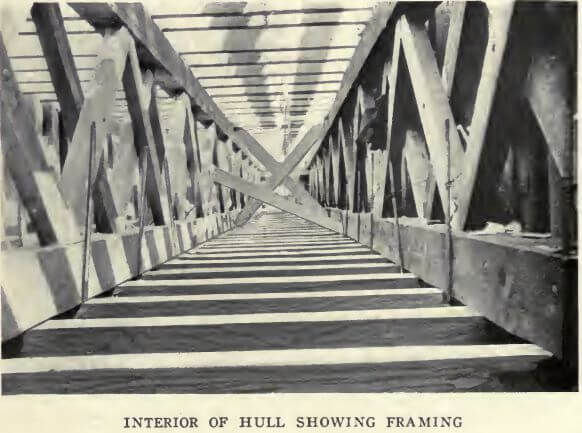
Hull
All of the machinery is mounted on a scow having a center well extending aft to about amidships; this scow is designed according to the requirements and must be exceedingly stiff. It is stanchly built of the best selected timber, with heavy frames closely spaced and tied together by longitudinal stringers and by two solid bulk-heads running fore and aft through the middle of scow on each side of the well.
Steel Super-Structure
We have just completed a dredge wherein the forward, main and stern gantries, together with the entire truss work, are of structural steel latticed girders; the whole, when completed, forms a Howe Trussed Girder extending the entire length of the dredge, as illustrated on page 2.
In this construction, it will be noticed that all of the strains in digging are confined within this complete steel structure and are not transmitted through the hull, as in the ordinary form of wooden construction, wherein the wooden truss is built up as part of the hull. This structural steel truss, or girder, is complete within itself and simply rests on the bottom of the hull, which only serves to float it. This relieves the hull from many of the strains that tend to wreck it.
This is quite a radical departure from anything heretofore attempted, and while it makes quite an expensive form of construction, still we believe that the results justify this expense. We are also prepared to design and build complete steel hulls when advisable.
These are so built that they can be knocked down for shipment or transportation, and readily assembled on the ground.
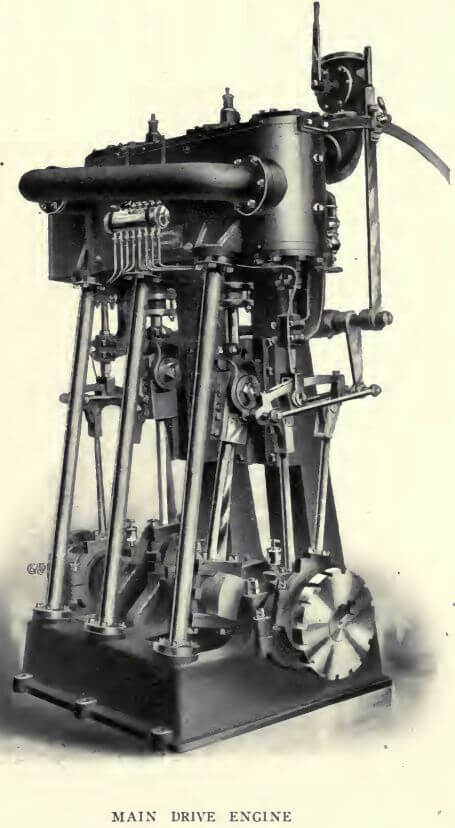
Dredge Engines
In the steam-driven dredge the main bucket-drive engine is of the double-cylinder marine type, reversible, exceedingly heavy, with extra large shaft and cranks, and in our large size, is compound condensing. The water used in washing the gravel is pumped through the condenser on its way to the screen; and, therefore, serves for both condensing and washing purposes. Auxiliary engines of special design and of substantial character serve to drive the other apparatus on board, such as the screen, winch and conveyor.
Boiler
Our boiler, in most instances, is of a special water-tube type; and where wood is to be used, it is designed with an extra large and deep furnace, which is so important in burning the poorer grades of wood. All  of
of 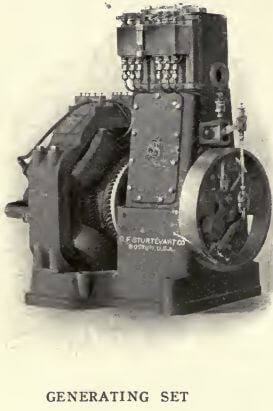 the tubes in this boiler are straight and accessible, and therefore readily cleaned. This boiler is self-contained and set within heavy sheet iron work, lined with asbestos, excepting the furnace, which is lined with firebrick so arranged as to be readily renewed. As the exhaust steam is condensed and returned to the boiler, there is no danger of the boiler becoming fouled with mud or scale.
the tubes in this boiler are straight and accessible, and therefore readily cleaned. This boiler is self-contained and set within heavy sheet iron work, lined with asbestos, excepting the furnace, which is lined with firebrick so arranged as to be readily renewed. As the exhaust steam is condensed and returned to the boiler, there is no danger of the boiler becoming fouled with mud or scale.
Electrical Equipment
Our steam dredge is usually arranged so that it can be changed into an electrically-driven dredge by substituting electric motors for the engines and taking off the boiler. Alternate current is always used on account of its many advantages in long-distance transmission; the motors, being of the induction type, are also better suited for dredging purposes than direct current motors.
The motors are all fused to cut out at a certain overload, and circuit-breakers are also installed to act automatically at a desired overload. The current is brought on board the dredge through water-proof flexible cable at high tension, and then transformed or stepped down for the different motors, as well as for the lighting circuits. In our steam-driven dredge a complete self-contained, steam-driven generator or dynamo set is furnished for lighting the dredge.
On our electric dredge we have a separate motor for each drive. The bucket-line driving motor is connected by a belt and gearing so as to give flexibility, and when the buckets strike against an obstruction in digging, an automatic release, or circuit-breaker, stops the chain of buckets instantly. Most of the motors on board are direct-connected.
Our Ideals
There has been a marked tendency on the part of several builders of gold dredges to standardize design; and in order to save expense, to supply a stock dredge of one design for all kinds of work. This is like attempting to cure all ills with a universal remedy—a manifest impossibility.
We believe that each dredge should be designed and constructed to suit the conditions under which it is to operate, therefore we study each proposition thoroughly and design and build accordingly, instead of trying to make one equipment fit all conditions.
In designing our dredge, we have made simplicity one of the fundamental features, and we have made a specialty of developing the wearing parts, making them renewable at every point practicable with as little expense and loss of time as possible. We use special hard steels in every place advisable in order to give extra long life and durability to these parts.
A greater factor of safety is used in dredging than in any other line of work, for the repairs and consequent shutdowns must be kept at a minimum. These are the most serious items of expense in operating.
Export Work
Our geographical position favors us for all export work. Our definite knowledge of all the various placer grounds of the world, and especially the particular conditions under which they exist, enables us to command this export work. Since we have become active in this field, we have secured all the contracts for every dredge that has been exported from this country.
We have given special attention to conditions in Colombia, British, Dutch and French Guiana, Brazil, Venezuela, Terra del Fuego and Siberia, and we have the knowledge that best fits us to build dredges for these and other foreign countries. We design our dredges and make shipment according to these conditions, giving due regard to weight and size of largest pieces.
As we are making a specialty of export work, we find that our dredges are often compared with those of foreign makers, and in so doing, one discovers a great difference in prices and a greater difference in weights. We therefore ask that in making this comparison, that it be noted that the American gold dredges are usually more than double the weight of the foreign dredges, and the use of special high grades of steel is extensively carried out by us. While our cost is much greater, the net results more than justify this extra cost.
The ideal dredge handles a large yardage at a low cost and our dredge has been developed to this ideal. The result is that the American dredges are digging far more ground and make a cleaner saving at less, cost per cubic yard than are any other dredges of today. Therefore, if one is considering final, definite results, they will do well to study the history and success of American dredges and make a close comparison with other dredges before deciding.
A brief comparison between one of the leading European makes and our dredge is herewith given below:

It will readily be seen from this, that, while the buckets of the foreign dredge are twenty-five per cent larger, yet they have only one-half the power to drive them and they run less than one-half as fast. They also weigh only half as much. The great disparity in total weight of machinery speaks for itself and readily explains why the American
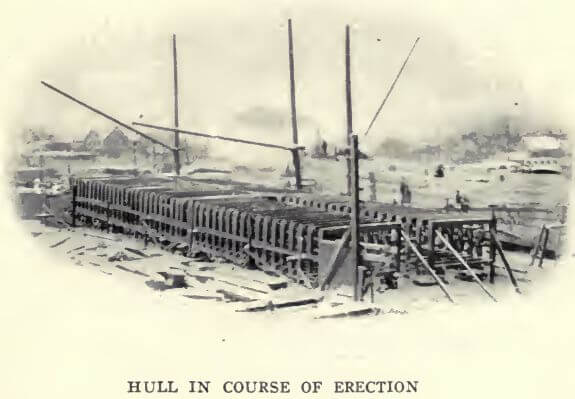
dredges stand up to the hardest kind of work, and give far more profitable and satisfactory results in their operation.
 We prefer to build and erect dredges complete and turn them over running, or we will furnish the machinery only f. o. b., in which case we send a full set of working plans and instructions. We will send competent men to superintend the entire construction of hull and erection of machinery and put the dredge in full and complete operation, breaking in and training the local laborers to operate same.
We prefer to build and erect dredges complete and turn them over running, or we will furnish the machinery only f. o. b., in which case we send a full set of working plans and instructions. We will send competent men to superintend the entire construction of hull and erection of machinery and put the dredge in full and complete operation, breaking in and training the local laborers to operate same.
Where two or more dredges are to be installed, it is generally advisable to have them electrically-driven with the power-generating station located where convenient to fuel, etc., and to have the current transmitted to the dredge. This arrangement saves room on board the dredge, by doing away with the boiler, etc., and it is also a saving in doing away with the hauling and handling of fuel.
Power Plants
Where head and quantity of water can be secured, electrical power can be generated and transmitted any reasonable distance to the dredge. Where a central power-generating station is required, we are prepared to design and build the same complete in every detail, either with water or steam power; we have had large experience in this line of work.
As no two dredge propositions are alike, we prefer to have one of our representatives visit the ground, and we have competent engineers for this particular work. Thus we can, in each particular instance, recommend and advise to the best advantage, concerning the size and other details of the dredge that always require modifications to fit the particular conditions peculiar to each dredging area. We have had considerable experience in working ground containing a large percentage of clay; we have been able to handle it successfully with our special devices.
Dredge Sizes and Capacities
Dredges are commonly known by the size of the buckets, that is, the cubical contents of each bucket, and the following sizes have been largely adhered to:
3½ cubic foot buckets, which have a theoretical capacity of about 3000 cubic yards in 24 hours.
5 cubic foot buckets, which have a theoretical capacity of about 5000 cubic yards in 24 hours.
7 cubic foot buckets, which have a theoretical capacity of about 6500 cubic yards in 24 hours.
10 cubic foot buckets, which have a theoretical capacity of about 9000 cubic yards in 24 hours.
13 cubic foot buckets, which have a theoretical capacity of about 12,000 cubic yards in 24 hours.
Their actual digging capacity will vary considerably and is dependent, not only upon the character of the ground, but also upon the ability of the dredge-man and many local conditions. A fair average, however, in actual digging is about from 60 to 70 per cent of the theoretical capacity.
Prospecting.—Prospecting dredging ground is usually simple and cheap, and money devoted to this object makes far more certain the knowledge of returns, and it results in the installation of suitable dredges. The Empire Hand Prospecting Drill is well adapted for this work.
We advise careful prospecting of the ground before the installation of the dredge; for it is far more satisfactory for you to have the dredge designed and built so that it is best adapted to the conditions under which it is to operate. We also take pride in having our dredges work well and thus be worthy of our name. We build nothing but gold-dredging machinery, and therefore we must build the best gold dredges, otherwise we would fail, for we have no other line of product to rely on. With all other manufacturers, dredge building is merely a side issue.
Dredging
The popular conception of mining enterprises is one of extremely large returns on an investment, or nothing at all; in other words, a gamble where luck and chance govern all. On the other hand, industrial or commercial enterprises are generally supposed to give a moderate but sure profit on the investment. It has remained for the dredging of gold, from alluvial areas, to upset previous notions in these regards and to demonstrate beyond a question that such mining is as much a business enterprise as is any manufacturing industry. It has the great advantage of having an absolutely unlimited and unfluctuating demand for its product which is not possessed by any other business than that of producing gold, the standard of all values.
For this reason gold-dredging is attracting widespread attention among investors and offers great inducements to them; and when the ground is properly prospected and equipped with a skillfully designed and well-built dredge the returns can be predicted with an exactness that challenges belief. Thus, corporations operating gold dredges have calculated returns for years in advance, and results have shown an accuracy in forecasting the returns that is not to be equalled in manufacturing, or in the marketing of any other products. Market conditions, supply and demand, as well as other changeable factors, set all calculations at variance, while gold—the product of gold-dredging—has a market and a value absolutely unwavering and a demand unlimited. In times of panic or business depression, the gold dredges roll on, and their products, in greater demand than ever, are sent to the mint in exchange for gold coin.
Conditions
It is not easy to state in exact terms just what conditions are essential for success in gold-dredging, but there are a number of factors which have such an individual importance that the lack of any one of them may result in failure where otherwise success should have been attained.
There is no one governing condition more important than machinery of design and construction suitable for working in the area chosen for exploitation by the dredging method. Thus, there are several instances where faulty design or construction have wrecked undertakings where a plentitude of gold should have furnished rich reward. Therefore, we emphasize not only the advantage of care in the selection of the dredging plant, but also the importance of thorough and careful investigation of the dredging ground under consideration, so that the dredge may be designed and built to meet the existing conditions. To assist in this matter, we are manufacturing the Empire Hand Prospecting Drill, which is the best tool for testing dredging ground.
We are dredge operators ourselves, and we are in a position to advise prospective buyers in all regards, and a wide and varied experience makes our advices on dredging matters valuable.
We are also in a position to assist those having dredging ground of proven value, in financing the same. Unlike some manufacturers, we have no fads or fancies, and our sole object is to build and supply suitable dredges of great weight and strength and of the best material and designed for the most economical operation.
Dredging Possibilities
The application of the dredging process is wide, and it is becoming more comprehensive. In early operations it was confined to river beds, but now flats adjacent to rivers, benches or terraces nearby, deposits in arid regions, sea beaches and bottoms, lake bottoms and frozen gravel in frigid zones, are also handled with success. The one paradox seems to be the dredging of arid areas, but water sufficient for floating dredges is now had by pumping from deep wells, drilled for that purpose with the Empire Hand Drill. The quantity of water required by dredge is small, generally 500 gallons per minute is ample. Thus, dredging is a wide industry and includes such enterprises as excavating lake bottoms for Aztec ornaments of gold (cast into the waters to acquire favor from the gods and protection from the invading Spaniards), the recovery of diamonds, tin and other metals and minerals existing in deposits either subaqueous or subarial.
The ultimate depth to which dredges can dig has not been determined, and alluvion about 100 feet deep is now being handled with great success. The probability is that this depth will be materially increased. Greater depths have not been attempted at present, because no areas possessing dredgeable characteristics and of greater depth than 100 feet have been investigated. Banks as high as 30 feet above the water level are successfully handled.
In order that one may understand what difficult ground has been successfully dredged, and in many cases seemingly unsurmountable obstacles having been encountered, we cite a few examples, as follows: Dredging in arid regions (as noted before) ; dredging cemented gravel so indurated that it must be blasted; dredging frozen gravel some of which must first be thawed; dredging gravel lying on a tough, blocky, schist bedrock, and to a depth of six feet into the bedrock; dredging gravel which contains occasional boulders weighing two tons, and having overburden over thirty feet deep or sometimes containing tenacious clay and buried timbers. These are a few instances of what may be accomplished where intelligent investigation, appropriately designed and well constructed machinery have combined to bring about great success.
Dredging Dry Placers
It is often supposed that dredging can only be carried on in rivers, or that the placer must be fully under water. This is erroneous, as interior or paddock dredging is carried on where there is no body of water; in fact, it may be done on elevated benches or plateaus, or in flat and arid areas devoid of any running water. To accomplish this it is only necessary to form a small pond about two hundred feet square and four or five feet deep. This may be done by excavating or damming, thus forming a pond to float the dredge in; and a small supply of water, which can be pumped or flumed from a distance, will take care of the seepage and evaporation. In this small pond the dredge can be made to travel over any part of the property and carry the pond along with it, inasmuch as the dredge fills in behind with the material that is removed from the front.
The introduction of gold-dredging has widened the mining horizon to a considerable degree, and there are great volumes of gold in subaqueous deposits formerly unattainable, but now placed within the reach of recovery by this process.
There are also large amounts of gold in deposits subaqueous not heretofore workable but that are now successfully exploited because of the cheapness of dredging. There is only one method of placer mining cheaper in operation— hydraulic mining—and then only under conditions that must be considered unique. As a general statement, dredging is the cheapest known method of mining, and it is not at all unlikely that the lowest cost of hydraulic mining (1½ cents per cubic yard) will soon be surpassed in dredging (the lowest cost for dredging, at present, is 2¼ cents per cubic yard, with further reductions in prospect). Countries like those of South America possess immense possibilities in the dredging field, having produced from placers over Two Billion Dollars ($2,000,000,000.00) worth of gold, or about one-fourth of the total gold product of the world.
Any rivers draining auriferous districts are worthy of investigation. Thus, all the continents and many of their sub-divisions have possibilities awaiting investigation and development of dredging areas which will add materially to the gold production of the world.
Almost every known type of dredge has been tried for gold dredging. One of the most attractive types is the suction, or hydraulic dredge, which sticks up the sand and gravel with a large quantity of water. The water, thus pumped up, thereafter serves the purpose of sluicing, being practically one operation. There is a difference of opinion concerning the utility of using a centrifugal pump, or suction dredge, for handling gold-bearing gravel. It is claimed by some that grains of gold can be elevated and carried through the discharge pipe of the pump, because the velocity of flow is so much greater than the velocity at which grains of gold will fall through the water. This is true, and if the grains of gold could be introduced into the mouth of the suction pipe they would assuredly be elevated and passed through the pump into the riffles, and would there be caught.
But this is not the difficulty with this form of dredge. The difficulty is that the force of the suction, being intense close to the suction pipe and rapidly decreasing in intensity a short distance from the suction, causes all the sand and gravel to be picked up and leaves the gold behind, due to its greater specific gravity. Furthermore, the suction dredge cannot work in stones or bowlders. The use of a centrifugal pump, therefore, for cleaning up the bottom and picking up the gold is impracticable, especially if the gold be coarse and the bed rock uneven. A rotary cutter on the suction pipe does not remedy the difficulty, because it only agitates the gravel and further precipitates the gold.
The dipper dredge has also been used, but in most cases has been abandoned, although it is an admirable machine as a dredge and will handle any ordinary material. It is not adapted for placer-mining, because it disturbs the gravel in the act of digging, so that a considerable portion of the gold is lost. It is well known that agitation of gold-bearing gravel under water induces the precipitation of the gold ; in fact, it is precisely this quality on which the whole operation of sluicing and gold washing depends.
It is, moreover, mechanically impossible to construct a dipper door which will be absolutely water-tight. Naturally, therefore, much of the fine gravel in the bottom of the dipper leaks out and carries gold with it. Various packings and devices for making the dipper door water-tight have been tried, but none are successful. A certain amount of looseness is necessary to its proper working. A bit of gravel would prevent a tightly fitted door from closing, and it would inevitably become loose by wear in any case.
Another objection to the dipper dredge is that it deposits the material intermittently, several tons at a time, and at a long distance from the centre of the dredge, so that it is difficult to take care of the material delivered in this way. It is necessary to have a large hopper either on the bank or on an auxiliary scow, and to feed the gravel out of this hopper into sluice-boxes or other appliances.
The same objections apply to the clamshell form of dredge to an even greater degree, as it is by no means water-tight, and loses most of the gold in the act of bringing up the gravel.
In the elevator dredge none of the foregoing objections are found. The action of the endless chain of buckets is slow and quiet, and the material is picked up clean from the bottom with the smallest amount of agitation, and in a manner best calculated to retain the gold. The buckets are water-tight, and retain their entire contents until emptied by inversion at the top. The delivery of material is continuous and at the centre of the boat, instead of being intermittent and at a distance over the side of the boat, as in the dipper dredge. The elevator buckets also bring up a considerable proportion of water, which facilitates the washing operation, and the material is brought up in smaller masses than in the case of the dipper dredge, and, hence, is more easily broken and disintegrated in the screen. For all of these reasons it is the ideal type of dredge for river mining. This conclusion is confirmed by the fact that all the dredges in the Australian and New Zealand gold fields are of this type, and a large number of them are successfully in use there.
The elevator, or chain-bucket dredge, is not new; in fact, it is one of the earliest known types. Some very good dredges of this type were brought to America from the Clyde in 1832 for use on the river St. Lawrence. They had engines of the side-lever type, and did very effective work with 6 pounds of steam.
On the opposite page is shown a typical gold dredge. This machine consists of the following elements:— 1st, the dredging apparatus proper, comprising the chain of buckets and means for driving them; 2d, a steel hopper into which the material is discharged ; 3d. a revolving screen in which it is washed and by means of which the coarse stones are rejected; 4th, a sluice-box for carrying off the fine tailings and discharging them astern; and 5th, a centrifugal pump for furnishing the necessary water for sluicing and washing purposes. All these details have been successfully combined so as to make a complete machine, capable of dredging and treating 3,000 cubic yards of material per day. The operations are simple and continuous, and under perfect control.
The vastness of the field thus opened up is incalculable. Thousands of miles of good gravel deposits, beyond the reach of all other known methods, can now be made available at a low working cost. One of these dredges can do the work of a thousand men working in the old way; and not only that, it can reach depths and clean up bed rock that would be totally inaccessible by the combined labour of any number of men. The work of gold dredges has already become a perceptible factor in the world’s production of gold, and it is yet in its infancy and bound to increase.
Among the earliest successful dredges are those at Bannock, Montana, on Grasshopper Creek, in the United States, where three dredges are at work. The ground is not phenomenally rich, varying from 10 cents to 40 cents per cubic yard; but the dredges have maintained a steady average of work which has yielded “clean-ups” varying from $500 to $3000 per day.
On page 34 is shown a bird’s-eye view of the valley of the Grasshopper with one of the dredges in the distance. The creek is quite small, averaging 20 feet wide by a foot deep; but the dredges work out the whole area of the valley bottom and work at different levels controlled by dams.
The whole field of dredging for gold is yet in its infancy, and it offers a promising field for investment under proper conditions. A large amount of placer-mining property yet remains to be opened up that can be worked only by dredging. The improvement of modern methods, by which large capacity can be maintained at low operating cost, renders the working of low-grade ground possible at a good profit. The proverbial uncertainty of mining is largely eliminated, and by taking proper precaution and proceeding on business principles, dredging for gold becomes simply a manufacturing proposition.
There are many good claims and river leases lying undeveloped for want of capital and for want of knowledge of how to produce certainty of results. If the results can be assured with reasonable certainty, capital will not be slow to embrace the opportunity. Many costly experiments have been made, some of which have been total failures, some partial failures and some successes. Capitalists, naturally and wisely, are reluctant to put money into schemes that may result in similar failure. An intelligent examination of these cases shows that in every instance failure has been due to some evident cause.
Some of these causes are the following:
1st, the adoption of the wrong type of dredge, such as suction, clamshell, and other unsuitable types, which, for specific reasons, cannot be made a success for dredging gold: 2d, erroneous diagnosis of the conditions to be fulfilled as to the character of material and method of working, and the consequent lack of adaptability of the machine to those conditions; 3d, faulty design of the machinery, either in general arrangement or detail, so that it fails in point of insufficient capacity, frequent breakdowns, inability to dispose of tailings, inability to clean “bed rock,” inability to save the gold, and excessive cost of operation in proportion to work done; 4th, poor management ; 5th, not enough gold in ground to pay; 6th, organisation by a “promoter” for stock jobbing purposes; 7th, operation by an “inventor” who has a new machine, and can do what no one else has ever done; 8th, lack of capital to efficiently carry on the enterprise; 9th, ground not suitable for dredging; and, 10th, character of gold such that it cannot be commercially saved.
“Forewarned is forearmed,” and to avoid these and other rocks and shoals it is necessary to have a knowledge of them. It is practically impossible for any one but an expert to determine all the points that must be covered from a mechanical, commercial and legal point of view; but enough has been said to indicate the general character of this new industry and the lines on which it can be successfully carried on.
Historical
The elevator or bucket type of dredge had its origin in the remote but advanced country of New Zealand, and much of its development was brought about in that country, but it remained for American enterprise to improve the New Zealand type and bring it to its present state of perfection.
In the beginning, the natives of New Zealand used a bag, made of sheepskin, laced around or on to an iron frame which was attached to the end of a pole or sweep; this was mounted on a raft of crude construction and arranged so that the bag could be dragged along the bottom of the river, and when filled, raised and its contents rocked, or sluiced, and the gold thus recovered; man power was used exclusively. This crude form finally evolved into the prototype of today, having a line of very light sheet-iron buckets operating at the end of a small boat. But it remained for American ingenuity to bring the gold dredge to its present-day maximum development in which we find a machine of tremendous weight, strength and capacity, digging approximately 200,000 cubic yards per month in alluvion 100 feet deep, at a less cost than ever before.
Many of our features and designs are covered by patents, and we trust they will be respected by all other manufacturers.
We have had a broad experience in the handling of large quantities of material and are particularly well equipped to work out any special designs in the handling of gravel containing black sand and other valuable minerals or precious stones.
On receipt of general information we will be glad to make suggestions and quote prices and terms.
Your correspondence is earnestly solicited.

